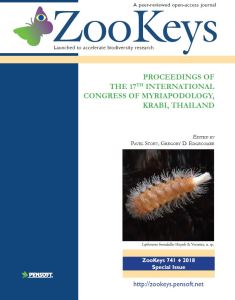In an effort to improve the quality of biodiversity records, the Atlas of Living Australia (ALA) and the Global Biodiversity Information Facility (GBIF) use automated data processing to check individual data items. The records are provided to the ALA and GBIF by museums, herbaria and other biodiversity data sources.
However, an independent analysis of such records reports that ALA and GBIF data processing also leads to data loss and unjustified changes in scientific names.
The study was carried out by Dr Robert Mesibov, an Australian millipede specialist who also works as a data auditor. Dr Mesibov checked around 800,000 records retrieved from the Australian Museum, Museums Victoria and the New Zealand Arthropod Collection. His results are published in the open access journal ZooKeys, and also archived in a public data repository.
“I was mainly interested in changes made by the aggregators to the genus and species names in the records,” said Dr Mesibov.
“I found that names in up to 1 in 5 records were changed, often because the aggregator couldn’t find the name in the look-up table it used.”
 Another worrying result concerned type specimens – the reference specimens upon which scientific names are based. On a number of occasions, the aggregators were found to have replaced the name of a type specimen with a name tied to an entirely different type specimen.
Another worrying result concerned type specimens – the reference specimens upon which scientific names are based. On a number of occasions, the aggregators were found to have replaced the name of a type specimen with a name tied to an entirely different type specimen.
The biggest surprise, according to Dr Mesibov, was the major disagreement on names between aggregators.
“There was very little agreement,” he explained. “One aggregator would change a name and the other wouldn’t, or would change it in a different way.”
Furthermore, dates, names and locality information were sometimes lost from records, mainly due to programming errors in the software used by aggregators to check data items. In some data fields the loss reached 100%, with no original data items surviving the processing.
“The lesson from this audit is that biodiversity data aggregation isn’t harmless,” said Dr Mesibov. “It can lose and confuse perfectly good data.”
“Users of aggregated data should always download both original and processed data items, and should check for data loss or modification, and for replacement of names,” he concluded.
###
Original source:
Mesibov R (2018) An audit of some filtering effects in aggregated occurrence records. ZooKeys 751: 129-146. https:/












 A dedicated
A dedicated 


 In conclusion, the authors note that given the latitude they discovered all of the studied moths, it is highly likely that more species belonging to the newly described genera are pending discovery in the adjacent countries – especially India.
In conclusion, the authors note that given the latitude they discovered all of the studied moths, it is highly likely that more species belonging to the newly described genera are pending discovery in the adjacent countries – especially India.
 The scientists remind that, back in 1972, when Anthony Burgess explained the title of his famous novel A Clockwork Orange, he said: “I’ve implied the junction of the organic, the lively, the sweet – in other words, life, the orange – and the mechanical, the cold, the disciplined (…)”
The scientists remind that, back in 1972, when Anthony Burgess explained the title of his famous novel A Clockwork Orange, he said: “I’ve implied the junction of the organic, the lively, the sweet – in other words, life, the orange – and the mechanical, the cold, the disciplined (…)”

 Wood says pelican spiders are well known among arachnologists not only for their unusual appearance, but also for the way they use their long “necks” and jaw-like mouthparts to prey on other spiders. “These spiders attest to the unique biology that diversified in Madagascar,” she said.
Wood says pelican spiders are well known among arachnologists not only for their unusual appearance, but also for the way they use their long “necks” and jaw-like mouthparts to prey on other spiders. “These spiders attest to the unique biology that diversified in Madagascar,” she said.

![Ochyrocera varys predating on a fly [Fig. 21 A]](https://i0.wp.com/blog.pensoft.net/wp-content/uploads/2018/01/Ochyrocera-varys-predating-on-a-fly-Fig.-21-A.jpg?resize=300%2C225) The list of ‘fantasy’ spiders begins with Ochyrocera varys named after Lord Varys from George R. R. Martin’s book series A Song of Ice and Fire. Lord Varys is also known as the Spider because of his manipulative skills and ability to ‘weave’ and command his networks of eyes-and-ears across two continents.
The list of ‘fantasy’ spiders begins with Ochyrocera varys named after Lord Varys from George R. R. Martin’s book series A Song of Ice and Fire. Lord Varys is also known as the Spider because of his manipulative skills and ability to ‘weave’ and command his networks of eyes-and-ears across two continents.![A couple of Ochyrocera misspider [Fig. 21 C]](https://i0.wp.com/blog.pensoft.net/wp-content/uploads/2018/01/A-couple-of-Ochyrocera-misspider-Fig.-21-C.jpg?resize=300%2C225)